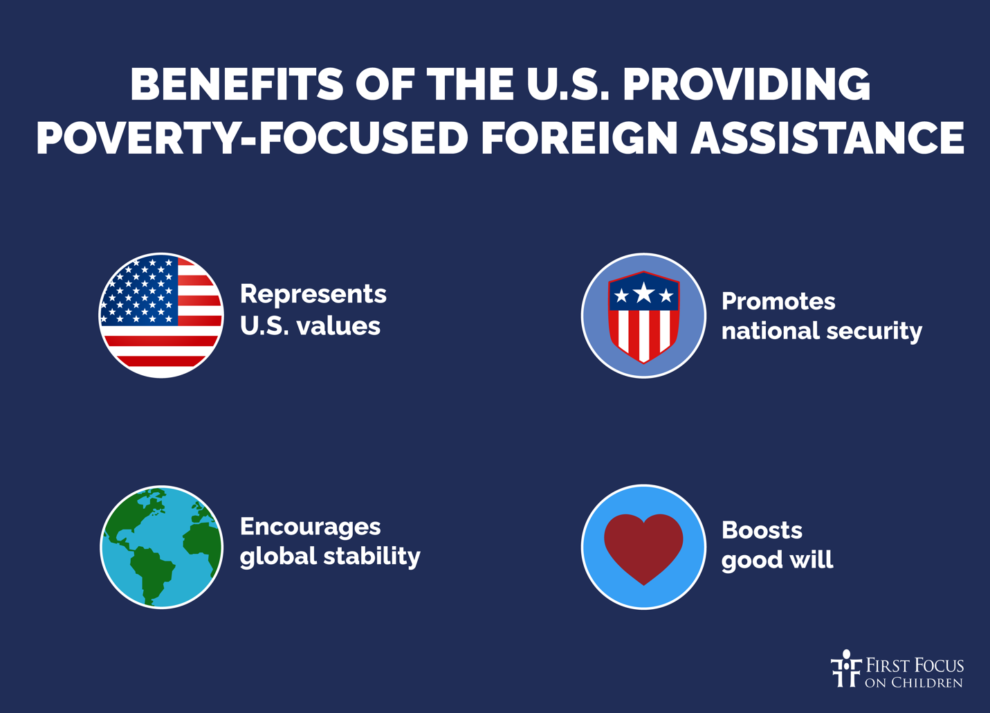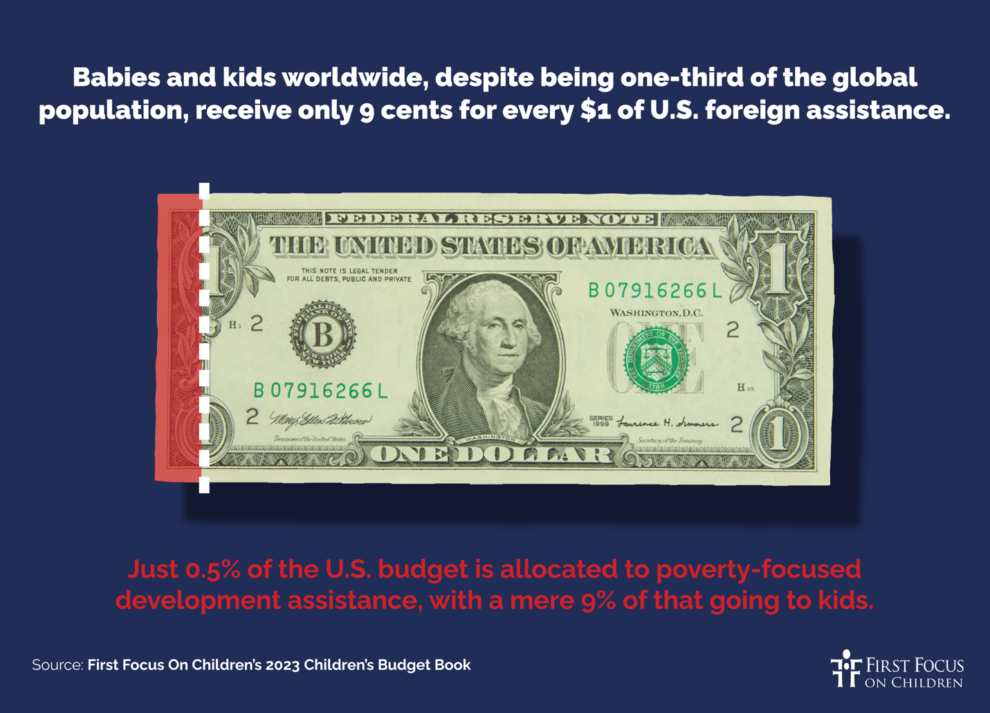The United States provides poverty-focused foreign assistance to poor countries to promote global health, security, and democracy, to reduce the worst aspects of poverty, and to respond to disasters and crises. This type of foreign assistance is not only the right thing to do, and represents the best of our American values, but it is the smart thing to do. It promotes national security, global stability, and international trade while reinforcing our diplomatic and strategic priorities by boosting goodwill.

U.S. Foreign Assistance Has Achieved Great Things, But More Is Needed
Thanks in part to U.S. investment in poverty-focused development and humanitarian assistance, deaths of children under five years old due to preventable disease and malnutrition have fallen from more than 12 million a year in 1990 to around 5 million today. Other notable achievements over the past 20 years thanks to U.S. foreign aid include 5.5 million babies being born HIV-free and 25 million men, women and children being saved from HIV.
While these are huge triumphs to be celebrated, recent global setbacks including the COVID-19 pandemic, advancing climate change, new and ongoing conflicts, and mounting global food insecurity are putting these achievements at risk and heightening the urgency of refining our efforts. It is critical that the U.S. do all it can to ensure maximum impact of the limited pot of money spent on foreign assistance, especially the dollars spent on behalf of the most vulnerable children. The fact is, like elsewhere in our U.S. budget, children have never received the attention or share of foreign assistance budget resources they deserve. And it shows.
Children Are in Crisis
According to UNICEF, children are more likely to live in poverty than adults and more vulnerable to its effects.
“Children who grow up impoverished often lack the food, sanitation, shelter, health care and education they need to survive and thrive. Across the world, about 1 billion children are ‘multidimensionally’ poor, meaning they lack necessities as basic as nutritious food or clean water. Worldwide, the poorest children are twice as likely to die in childhood than their wealthier peers.”
Children make up half of those living in absolute poverty worldwide despite being 30 percent of the population. Poverty, and everything that comes with it, has a devastating impact on child development.
In addition to shortening their life spans, absolute poverty means sickness and suffering for children that stunts the growth of their bodies and brains—robbing them, their families, and their nations of their full potential. According to a report in The Lancet
“a staggering 43 percent of children under five years of age—an estimated 250 million—living in low- and middle-income countries are at risk of suboptimal development due to poverty and stunting. The burden is currently underestimated because risks to health and wellbeing go beyond these two factors.”
Congressional Action on Behalf of Children Worldwide
Over the past three decades, Champions for Children in the U.S. Congress have sought to address child mortality and stunting through funding increases in global nutrition and maternal and child health programming. Their leadership contributed to the dramatic drop in deaths of under-five-year-olds from preventable diseases and malnutrition.
Then in 2021, in an effort to make U.S. efforts even more impactful and ensure that kids were not just surviving but thriving, Reps. Joaquin Castro (D-TX), Brian Fitzpatrick (R-PA) and Sens. Chris Coons (D-DE), and Roy Blunt (R-MO) secured passage of the Global Child Thrive Act (GCTA) mandating the integration of Early Childhood Development (ECD) into U.S. foreign aid programs serving kids. By integrating ECD into current interventions, Congressional Champions for Children were following the science and multiplying the positive impacts of already successful U.S. international programming. Incorporating parent training on responsive caregiving into a maternal and child health program, for example, takes that program to the next level and ensures that children not only live beyond their fifth birthday but that their brains and bodies develop to their full potential too.
Where is USAID on Implementation of the Global Child Thrive Act?
Since the passage of the Global Child Thrive Act, the U.S. Agency for International Development (USAID) has released implementation guidance designed for easy use by U.S. missions around the globe. This is a good step in the right direction. However, funding and leadership to successfully implement the law are desperately needed.
Implementation of the act falls to the tiny and vastly under-resourced Children in Adversity Office at USAID. This office is funded each year by a miniscule pot of money (roughly $30 million) called the Vulnerable Children Account within the State, Foreign Operations Appropriations bill. The Children in Adversity Office does some of the most important child-focused work in the world by promoting care for the most vulnerable children, protecting children from violence and neglect, and supporting family care (as opposed to orphanages or institutions which tend to have harmful implications for child well-being and development). But, due to its small staff and lack of resources, the office’s reach has been limited, as is its ability to ensure the implementation of the Global Child Thrive Act all on its own.
What Do the World’s Children Deserve?
What would the world look like for children if Congress, the Administration, USAID, and U.S. foreign assistance funding were to adequately focus on their developmental needs and provide them their fair share of resources?
As mentioned on our Speaking of Kids podcast, the amount of money the U.S. provides for foreign aid is modest to begin with. When polled, Americans estimate that 25 percent of the federal budget goes to international assistance. The truth is that just 1 percent of the U.S. federal budget goes toward foreign assistance—and within that, less than half is devoted to poverty-focused development and humanitarian programs. The remainder goes toward economic and security or military funding.
And when it comes to children in the foreign aid budget, we treat them the same as everywhere else: Children are always last and receive the least. Children have specific developmental needs and investing in them delivers an outsized return on investment. Yet our spending on kids is minuscule.
The U.S. budget currently skews investment toward adults, both domestically and globally. First Focus on Children works to make children the priority in federal budget and policy decisions, not only because it is the right thing to do, but because children are inherently vulnerable. Kids are more fragile than adults—unable to withstand periods of malnutrition or bouts of extreme heat or unclean water for as long as a grownup—so focusing on their needs first, rather than last or not at all, would save more lives—thereby more successfully achieving a top objective of U.S. poverty-focused foreign assistance. Additionally, it is the smart thing to do. Investing earlier in the human life cycle produces a bigger bang for the buck in terms of human brain growth, future health, and economic success.
First Focus on Children’s 2023 Children’s Budget documents that just 9 cents of every $1 of U.S. foreign assistance goes to babies and kids worldwide despite the fact that they make up a third of the population globally. So out of the one-half of one percent of the U.S. budget that goes to poverty-focused development assistance, just 9 percent of that modest pot of funding goes to kids.

With such meager funding provided for children, and such a tiny, under-resourced office dedicated to their well-being, it is no wonder that the Congressional mandate included in the Global Child Thrive Act to integrate early childhood development interventions into current programs serving vulnerable children has been so slow to take hold at the country-level. Indeed, three years after its passage, most U.S. missions worldwide are still minimally aware of the law’s existence.
And USAID leadership has thus far been silent on the importance of implementing the GCTA. Communication from the top down that the GCTA is a priority would move its enactment along, as would adequate funding for USAID missions to be able to follow through successfully.
Implementing and successfully funding the GCTA’s early childhood development mandate also would help break down some of the funding siloes inherent in U.S. foreign assistance. For instance, Congress generally provides U.S. foreign aid separately for schooling or health services or clean water, or nutritious food. But children are multi-dimensional and have physical, emotional, and cognitive needs that require a combination of all of those supports to achieve their full potential. Supporting children holistically with a “whole child” approach that takes into account their developmental stages and intersecting needs ensures better outcomes.
A Call to Action for Vulnerable Children
Children need the people in charge to prioritize their needs. Children all over the world face more challenges than ever. First Focus Campaign for Children calls on Congress to significantly expand resources for vulnerable children in the Fiscal Year 2025 State, Foreign Operations Appropriations bill to at least $35 million. USAID leadership must prioritize the Children in Adversity Office and its work to ensure effective and rapid implementation of the Global Child Thrive Act.
In addition, the Biden-Harris Administration must do all in its power to prioritize children globally and here at home. First Focus on Children recently called on President Biden to make children a cross-agency priority through the Office of Management and Budget and to implement child impact statements across agencies to assess the U.S. government’s impact on child well-being. Governments use child impact statements to build child well-being into policy design. As with environmental impact statements, this approach would require government agencies to address the potential positive and negative effects on children posed by regulations, rules, policies, programs, and guidance.
Much more can and should be done for our children. Our kids are in crisis and now is the time to act on their behalf.
